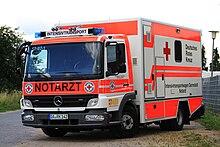Intensive care transport


As a critical care transport (including inter-hospital transport , inter-hospital transfer or secondary transfer ) refers to the transport of intensive care treated patients . Since the supply must not be interrupted during the transport from a hospital to the hospital providing further treatment, specially equipped transporters are necessary. Mainly special intensive care transport vehicles (ITW) and intensive care transport helicopters (ITH) are used.
Reasons for an intensive care transport can include a lack of equipment (e.g. no cardiac catheterization laboratory ), departments (e.g. no neurology ), capacities (e.g. no free intensive care bed) or resources (e.g. transfer after acute care for long-term therapy ) in the first care clinic or the location of the target clinic (e.g. proximity to relatives).
In Germany, intensive care transports are accompanied by a doctor , usually with additional emergency medical qualifications , whereby the German Interdisciplinary Association for Intensive Care and Emergency Medicine (DIVI) recommends additional qualifications. Intensive care transports are regulated in Germany in the respective state rescue service laws, provided that the state law provides corresponding regulations.
As an interim solution between ambulances and intensive care vehicles Bavaria was the first state in 2009 an additional laying doctor established that a relocation medical emergency vehicle are fed (PDB) and can accompany intensive care patients in a regular ambulance.
Individual evidence
- ↑ For medical qualifications for intensive care transport. German Interdisciplinary Association for Intensive Care and Emergency Medicine , as of November 30, 2004 (PDF; 80 kB). Retrieved May 18, 2019.
- ↑ a b A. Staufer, D. Mittelhammer: The transfer doctor in Bavaria . In: Emergency + Rescue Medicine . tape 14 , no. 4 , May 25, 2011, ISSN 1434-6222 , p. 291–296 , doi : 10.1007 / s10049-010-1384-x ( springer.com [accessed February 25, 2017]).